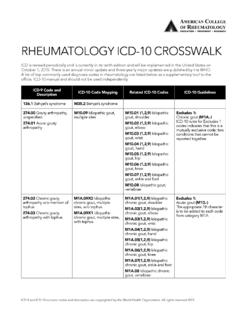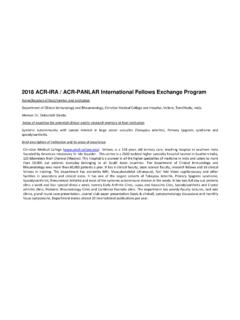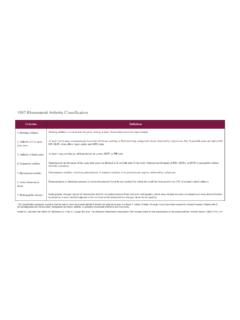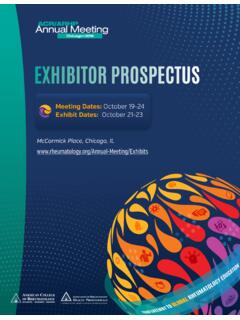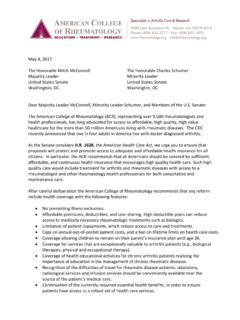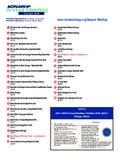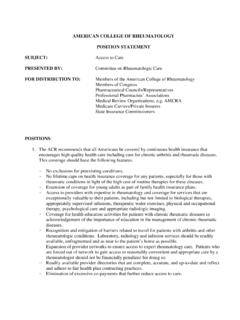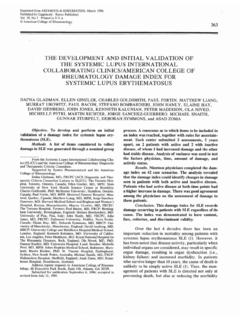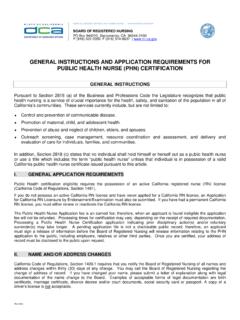Transcription of 2019 European League Against Rheumatism/American …
1 1400 Arthritis & RheumatologyVol. 71, No. 9, September 2019, pp 1400 1412 DOI 2019, American College of RheumatologySPECIAL ARTICLE2019 European League Against Rheumatism/American College of Rheumatology Classification Criteria for Systemic Lupus ErythematosusMartin Aringer,1 Karen Costenbader,2 David Daikh,3 Ralph Brinks,4 Marta Mosca,5 Rosalind Ramsey-Goldman,6 Josef S. Smolen,7 David Wofsy,8 Dimitrios T. Boumpas,9 Diane L. Kamen,10 David Jayne,11 Ricard Cervera,12 Nathalie Costedoat-Chalumeau,13 Betty Diamond,14 Dafna D. Gladman,15 Bevra Hahn,16 Falk Hiepe,17 S ren Jacobsen,18 Dinesh Khanna,19 Kirsten Lerstr m,20 Elena Massarotti,2 Joseph McCune,21 Guillermo Ruiz-Irastorza,22 Jorge Sanchez-Guerrero,23 Matthias Schneider,24 Murray Urowitz,25 George Bertsias,26 Bimba F.
2 Hoyer,27 Nicolai Leuchten,1 Chiara Tani,28 Sara K. Tedeschi,2 Zahi Touma,15 Gabriela Schmajuk,3 Branimir Anic,29 Florence Assan,30 Tak Mao Chan,31 Ann Elaine Clarke,32 Mary K. Crow,33 L szl Czirj k,34 Andrea Doria,35 Winfried Graninger,36 Bernadett Halda-Kiss,34 Sarfaraz Hasni,37 Peter M. Izmirly,38 Michelle Jung,32 G bor Kum novics,34 Xavier Mariette,39 Ivan Padjen,29 Jos M. Pego-Reigosa,40 Juanita Romero-Diaz,41 igo R a-Figueroa Fern ndez,42 Rapha le Seror,30 Georg H. Stummvoll,43 Yoshiya Tanaka,44 Maria G. Tektonidou,45 Carlos Vasconcelos,46 Edward M. Vital,47 Daniel J. Wallace,48 Sule Yavuz,49 Pier Luigi Meroni,50 Marvin J. Fritzler,32 Ray Naden,51 Thomas D rner,17 and Sindhu R. Johnson52 Objective. To develop new classification criteria for systemic lupus erythematosus (SLE) jointly supported by the European League Against Rheumatism (EULAR) and the American College of Rheumatology (ACR).
3 Methods. This international initiative had four phases. 1) Evaluation of antinuclear antibody (ANA) as an entry cri-terion through systematic review and meta- regression of the literature and criteria generation through an international Delphi exercise, an early patient cohort, and a patient survey. 2) Criteria reduction by Delphi and nominal group tech-nique exercises. 3) Criteria definition and weighting based on criterion performance and on results of a multi- criteria decision analysis. 4) Refinement of weights and threshold scores in a new derivation cohort of 1,001 subjects and validation compared with previous criteria in a new validation cohort of 1,270 The 2019 EULAR/ACR classification criteria for SLE include positive ANA at least once as obligatory en-try criterion; followed by additive weighted criteria grouped in 7 clinical (constitutional, hematologic, neuropsychiatric, mucocutaneous, serosal, musculoskeletal, renal) and 3 immunologic (antiphospholipid antibodies, complement pro-teins, SLE- specific antibodies) domains, and weighted from 2 to 10.
4 Patients accumulating 10 points are classified. In the validation cohort, the new criteria had a sensitivity of and specificity of , compared with sensitivity and specificity of the ACR 1997 and sensitivity and specificity of the Systemic Lupus International Collaborating Clinics 2012 criteria set has been approved by the European League Against Rheumatism (EULAR) Executive Com-mittee and the American College of Rheumatology (ACR) Board of Directors. This signifies that the criteria set has been quantitatively validated using patient data, and it has undergone validation based on an independent data set. All EULAR/ACR-approved criteria sets are expected to undergo intermittent ACR is an independent, professional, medical and scientific society that does not guarantee, warrant, or endorse any commercial product or CLASSIFICATION CRITERIA FOR SLE | 1401 Conclusion.
5 These new classification criteria were developed using rigorous methodology with multidisciplinary and international input, and have excellent sensitivity and specificity. Use of ANA entry criterion, hierarchically clus-tered, and weighted criteria reflects current thinking about SLE and provides an improved foundation for SLE lupus erythematosus (SLE) is a complex autoim-mune disease with variable clinical features (1,2). SLE manifesta-tions are associated with multiple autoantibodies, ensuing immune complex formation and deposition, and other immune processes (2,3). This complex clinical presentation and pathogenesis makes SLE a difficult disease to grasp and define. Classification crite-ria are essential for the identification of relatively homogeneous groups of patients for inclusion in research studies and trials (4,5).
6 The 1982 revised American College of Rheumatology (ACR) SLE classification criteria (6) and their 1997 revision (7) have been used worldwide. Since then, our understanding of the disease has advanced. Additional specific skin manifestations were described, some clinical symptoms were better understood, and immuno-logic tests, such as diminished levels of serum complement com-ponents C3 and C4 or testing for anti 2- glycoprotein I antibodies, entered routine clinical practice. Better understanding of organ system involvement, such as mucocutaneous abnormalities, led to questions about whether some of the independently counted criteria were in fact manifestations of the same phenomenon (8).The 2012 Systemic Lupus International Collaborating Clin-ics (SLICC) classification criteria addressed many of these issues (9).
7 Mucocutaneous and neuropsychiatric manifestations were added, as were hypocomplementemia and new antiphospholipid antibody tests; and criteria definitions were refined. The SLICC criteria emphasized that SLE is primarily an autoantibody disease, requiring at least one immunologic criterion to be present, and A video abstract of this article can be found at article is published simultaneously in the September 2019 issue of Annals of the Rheumatic by the European League Against Rheumatism and the American College of Rheumatology. One part of the derivation and validation cohort was supported by the Intramural Research Program of the National Institute of Arthritis and Musculoskeletal and Skin Diseases, Aringer, MD, Nicolai Leuchten, MD: University Medical Center and Faculty of Medicine Carl Gustav Carus, TU Dresden, Dresden, Germany; 2 Karen Costenbader, MD, MPH, Elena Massarotti, MD, Sara K.
8 Tedeschi, MD, MPH: Brigham and Women s Hospital, Harvard Medical School, Boston, Massachusetts; 3 David Daikh, MD, PhD, Gabriela Schmajuk, MD, MS: VA Medical Center and University of California, San Francisco; 4 Ralph Brinks, PhD: Heinrich Heine University Dusseldorf, Dusseldorf, Germany; 5 Marta Mosca, MD, PhD: University of Pisa, Pisa, Italy; 6 Rosalind Ramsey-Goldman, MD, DrPH: Northwestern University Feinberg School of Medicine, Chicago, Illinois; 7 Josef S. Smolen, MD: Medical University of Vienna, Vienna, Austria; 8 David Wofsy, MD: University of California, San Francisco; 9 Dimitrios T. Boumpas, MD: National and Kapodestrian University of Athens Medical School and Biomedical Research Foundation of the Academy of Athens, Athens, Greece, and University of Cyprus Medical School, Nicosia, Cyprus; 10 Diane L.
9 Kamen, MD, MSCR: Medical University of South Carolina, Charleston; 11 David Jayne, MD, FRCP, FRCPE, FMedSci: University of Cambridge, Cambridge, UK; 12 Ricard Cervera, MD, PhD, FRCP: Hospital Cl nic, University of Barcelona, Barcelona, Spain; 13 Nathalie Costedoat-Chalumeau, MD, PhD: Cochin Hospital, Center de r f rence maladies auto-immunes et syst miques rares d le de France, Paris, France; 14 Betty Diamond, MD: The Feinstein Institute for Medical Research, Manhasset, New York; 15 Dafna D. Gladman, MD, FRCPC, Zahi Touma, MD, PhD: Toronto Western Hospital, University of Toronto, Toronto, Ontario, Canada; 16 Bevra Hahn, MD: University of California, Los Angeles; 17 Falk Hiepe, MD, Thomas D rner, MD: Charit Universit tsmedizin Berlin, Freie Universit t Berlin, Humboldt-Universit t zu Berlin, Berlin Institute of Health, Berlin, Germany; 18S ren Jacobsen, MD, DMSc: Copenhagen Lupus and Vasculitis Clinic, Rigshospitalet, Copenhagen University Hospital, Copenhagen, Denmark; 19 Dinesh Khanna, MD, MS: University of Michigan, Ann Arbor; 20 Kirsten Lerstr m, MS: Lupus Europe, Essex, UK; 21 Joseph McCune, MD: University of Michigan, Ann Arbor.
10 22 Guillermo Ruiz-Irastorza, MD: Hospital Universitario Cruces, UPV/EHU, Barakaldo, Spain; 23 Jorge Sanchez-Guerrero, MD, MSc: Mount Sinai Hospital/University Health Network, University of Toronto, Toronto, Ontario, Canada, and Instituto Nacional de Ciencias M dicas y Nutrici n Salvador Zubir n, Mexico City, Mexico; 24 Matthias Schneider, MD: Heinrich-Heine-University, Duesseldorf, Germany; 25 Murray Urowitz, MD, FRCPC: Toronto Western Hospital, University of Toronto, Lupus Clinic, Toronto, Ontario, Canada; 26 George Bertsias, MD: University of Crete Medical School, Heraklion, Crete, Greece; 27 Bimba F. Hoyer, MD, PhD: Charit Universit tsmedizin Berlin, Freie Universit t Berlin, Humboldt-Universit t zu Berlin, Berlin Institute of Health, Berlin, Germany, and University of Schleswig-Holstein at Kiel, Kiel, Germany; 28 Chiara Tani, MD: Azienda Ospedaliero Universitaria Pisana, University of Pisa, Pisa, Italy; 29 Branimir Anic, MD, Ivan Padjen, MD: University of Zagreb School of Medicine and University Hospital Center Zagreb, Zagreb, Croatia; 30 Florence Assan, MD, Rapha le Seror, MD: Universit Paris Sud, H pitaux Universitaires Paris-Sud, AP-HP, INSERM 1184, Le Kremlin-Bic tre, France; 31 Tak Mao Chan, MD: University of Hong Kong, Hong Kong, China.

